

In the ever-shifting landscape of fashion, a clear division has emerged: fast fashion versus sustainable fashion. Fast fashion, synonymous with its rapid turnover of trendy yet affordable apparel, satisfies the relentless appetite of trend-driven consumers. On the other hand, sustainable fashion champions ethical practices and environmental stewardship, placing emphasis on durability, quality, and mindful sourcing.
Fast fashion, as defined by Merriam-Webster, revolves around swiftly making current fashion trends accessible and inexpensive to shoppers. Yet, the Economist paints a less flattering picture, depicting it as a cycle of "trendy clothes at astonishingly low prices," encouraging a culture of disposability. Designers in this realm stay attuned to the pulsating heartbeat of fashion, swiftly translating trends into wearable garments sourced from various corners of the globe, often prioritizing cost over sustainability.
In recent years, the fashion landscape has metamorphosed, giving rise to these two divergent ideologies. While fast fashion reigns supreme for its affordability and trendiness, sustainable fashion emerges as a conscious counterbalance, advocating for ethical sourcing and eco-friendly practices. This exploration delves into the core disparities between these approaches, illuminating their implications for consumers, workers, and the planet.
What Is Fast Fashion?
Fast fashion has revolutionized the way we approach clothing, offering a rapid response to the latest style trends at wallet-friendly prices. It's a phenomenon fueled by our insatiable appetite for trendy apparel at lightning speed. In this era, shopping has evolved beyond mere necessity; it's now a form of entertainment, drawing consumers to outlets that offer an immersive experience. Retailers adept at creating ambiance through enticing displays, lighting, and even fragrances enhance the customer journey, enticing them to indulge in the ultimate shopping experience.
At the heart of fast fashion lies its lightning-fast production cycles, where runway designs swiftly transition from catwalk to store shelves. These brands excel in churning out affordable clothing in lockstep with ever-changing trends. Their modus operandi? Cut production costs to the bone, offering irresistible price points that beckon consumers to indulge in frequent wardrobe updates. However, this rapid turnover fuels a throwaway culture, where garments are worn briefly before being discarded in favor of the next trendy piece.
In essence, fast fashion epitomizes the fusion of style and speed, catering to our desire for instant gratification in the realm of clothing. Yet, beneath the allure of affordability and trendiness lies a deeper societal impact, prompting us to question the sustainability of this frenetic consumption cycle.
How To Spot A Fast Fashion Brand?
Identifying fast fashion while shopping can prove tricky, given its infiltration across both mass-market and luxury sectors. Even with a higher price tag, a garment may not necessarily guarantee ethical sourcing. Here are some tips to discern fast fashion whether you're shopping in-store or online:
1. Examine the fabric label - Fast fashion typically utilizes non-biodegradable synthetic materials like nylon, polyester, spandex, and acrylic. These fabrics pose environmental and health risks.
2. Assess the material's feel - Fast fashion often employs thin, synthetic fabrics instead of more durable natural materials. Pay attention to whether the item feels flimsy or lightweight.
3. Scrutinize the quality - Take a close look at details such as stitching. Are there loose threads or uneven seams? Poor craftsmanship indicates rapid production.
4. Investigate the brand - Conduct online research to uncover information about the brand's supply chain and commitment to ethical practices. Lack of transparency regarding fair labor or sustainability suggests fast fashion tendencies.
5. Note the country of origin - Fast fashion frequently relies on mass production in low-wage countries with lax regulations. This can be indicative of fast fashion practices.
6. Consider the style - Is the item highly trendy, seemingly designed to capitalize on fleeting trends? Fast fashion often follows short-lived fads.
7. Monitor new arrivals frequency - Does the brand frequently release new collections? Fast fashion typically churns out inventory at a rapid pace.
Pros & Cons Of Fast Fashion
These pointers succinctly highlight both the benefits and drawbacks of fast fashion, encouraging consumers to consider the broader implications of their purchasing decisions.
Pros of Fast Fashion:
1. Affordability: Fast fashion makes trendy clothing accessible to a wide range of consumers at budget-friendly prices.
2. Quick Response to Trends: The rapid production cycles of fast fashion enable brands to swiftly respond to evolving fashion trends, keeping their offerings fresh and relevant.
3. Variety and Accessibility: The proliferation of fast fashion retailers ensures a diverse range of clothing options that are readily available to consumers, meeting their desires without significant wait times.
4. Thrill of Shopping: Particularly appealing to youth and students, fast fashion provides an opportunity to indulge in the excitement of shopping without breaking the bank.
Cons of Fast Fashion:
1. Worker Exploitation: Many fast fashion brands rely on subcontracted manufacturers in countries with lax labor regulations, leading to exploitative working conditions in sweatshops.
2. Environmental Impact: The rapid turnover of clothing in the fast fashion industry contributes significantly to textile waste, exacerbating environmental concerns. Additionally, the manufacturing process consumes vast resources such as water and coal.
3. Quality Concerns: While fast fashion offers affordability, the quality of garments often suffers, resulting in clothes that quickly deteriorate and require frequent replacements, ultimately costing consumers more in the long run.
4. Ethical Dilemmas: The pursuit of low prices in fast fashion raises ethical questions regarding labor rights, environmental sustainability, and the overall social impact of consumer choices.
What Is Sustainable Fashion?
Sustainable fashion stands in stark contrast to the throwaway culture perpetuated by fast fashion. While fast fashion encourages consumers to treat clothing as disposable commodities, sustainable fashion champions a more conscientious approach to consumption. At its core, sustainable fashion embodies principles of ethical production, responsible sourcing of materials, and fair treatment of workers.
Unlike their fast fashion counterparts, sustainable brands prioritize longevity and quality over fleeting trends. They advocate for the adoption of "slow fashion," a philosophy centered around buying fewer, but higher quality garments designed to withstand the test of time. By investing in durable pieces, consumers can reduce their environmental impact and curb the cycle of excessive consumption.
Furthermore, sustainable brands are committed to minimizing their ecological footprint by embracing eco-friendly materials and manufacturing processes. From utilizing organic cotton to recycled polyester, these brands seek innovative solutions to mitigate the environmental harm caused by traditional fashion practices. By adopting sustainable practices, they strive to foster a more harmonious relationship between fashion and the planet.
In essence, sustainable fashion offers a holistic alternative to the unsustainable practices of fast fashion. By prioritizing ethical production, responsible sourcing, and environmental stewardship, sustainable brands pave the way for a more equitable and sustainable future for the fashion industry and beyond.
How To Spot A Sustainable Fashion Brand?
Recognizing sustainable fashion brands empowers consumers to align their purchases with their values, promoting ethical practices and environmental stewardship within the fashion industry. By refusing to support fast fashion brands that overlook human rights violations and ecological harm in their supply chains, consumers can advocate for positive change through their buying decisions. Here's how you can discern sustainable fashion options when shopping:
1. Prioritize Materials - Sustainable fashion brands prioritize organic cotton, hemp, linen, and other non-toxic textiles, minimizing environmental impact and promoting healthier production processes.
2. Verify Certifications - Look for reputable certifications like Fair Trade and GOTS (Global Organic Textile Standard) that validate ethical and eco-friendly practices within the brand's operations.
3. Research the Brand - Take the time to delve into the brand's commitments to ethics and sustainability. Transparent brands readily share comprehensive information about their practices and values.
4. Embrace Limited Collections - Opt for brands that release limited collections emphasizing versatility over fleeting trends, promoting timeless style and reducing waste.
5. Support Local and Small-Scale Production - Consider purchasing from brands that prioritize small-scale or locally sourced production, supporting communities and minimizing environmental footprints.
6. Favor Repair and Recycling Initiatives - Choose brands that offer repair or recycling programs, extending the lifespan of garments and diverting materials from landfills.
Pros & Cons Of Sustainable Fashion
These pointers highlight both the benefits and challenges associated with sustainable fashion, offering insight into its role in shaping a more ethical and environmentally conscious fashion industry.
Pros of Sustainable Fashion
1. Ethical Treatment of Workers: Sustainable fashion prioritizes the fair treatment of workers, ensuring they receive fair wages and operate in safe working conditions.
2. Use of Eco-Friendly Materials: Sustainable fashion brands utilize eco-friendly materials, reducing their environmental impact compared to conventional fashion practices.
3. Promotes Quality Over Quantity: Sustainable fashion encourages a mindset of quality over quantity, advocating for garments designed to last longer, thus fostering a more sustainable consumption pattern.
Cons of Sustainable Fashion
1. Higher Initial Costs: The use of premium materials and fair labor practices in sustainable fashion often results in higher initial costs for consumers, making sustainable options less accessible to budget-conscious shoppers.
2. Limited Access for Budget: Conscious Consumers: Sustainable fashion may be perceived as exclusive or inaccessible to consumers on a tight budget, limiting its adoption among a broader audience.
3. Challenges in Keeping Up with Trends: Sustainable fashion brands may face challenges in keeping up with rapidly changing fashion trends, as the focus on durability and timeless design may clash with the fast-paced nature of the fashion industry.
What Should You Choose- Fast Fashion Or Sustainable Fashion?
When faced with the decision between fast fashion and sustainable fashion, consider the broader implications of your choices. Fast fashion may offer immediate affordability and trendy styles, but it perpetuates a cycle of environmental degradation and ethical concerns. On the other hand, sustainable fashion prioritizes ethical production practices and environmental stewardship, promoting durability and responsible consumption. By opting for sustainable fashion, you contribute to positive social and environmental impact, aligning your purchasing decisions with your values.
Ultimately, the choice between fast fashion and sustainable fashion reflects your values and the kind of world you wish to support. While fast fashion provides convenience and affordability in the short term, sustainable fashion embodies a commitment to long-term sustainability and ethical principles. By choosing sustainable fashion, you not only express your values but also contribute to creating a more equitable, ethical, and environmentally sustainable fashion industry for generations to come.
10 Sustainable Fashion Brands That Are Making Waves In India
Discovering sustainable fashion brands in India opens the door to a world where style meets conscience. In a country renowned for its rich textile heritage, these brands intertwine traditional craftsmanship with modern sustainability practices, offering a refreshing alternative to conventional fashion. From organic fabrics to ethical production, each brand on this list embodies a commitment to environmental and social responsibility. Join us as we explore the top 10 sustainable fashion brands in India, where innovation, ethics, and style converge to shape a more sustainable future for the fashion industry.
1. No Nasties
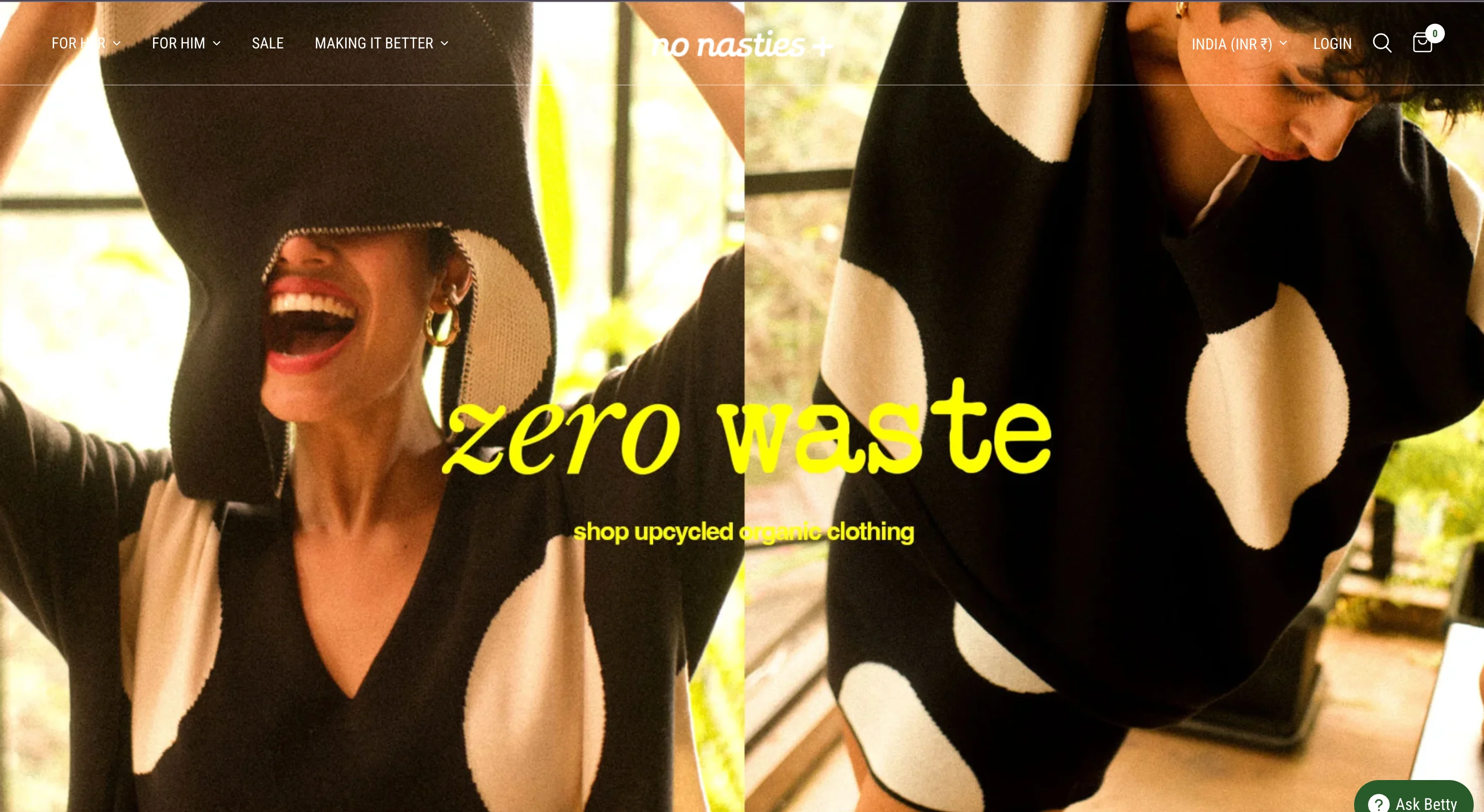
No Nasties, true to its name, stands as a beacon of fair trade, organic, and vegan fashion. With a mission to craft planet-positive clothing, they offset the carbon footprint of each product through investments in solar power, wind energy, and forest conservation.
Partnering with Green Story, a third-party analysis platform, they meticulously calculate their environmental impact, considering supply chains and material composition. Their collection features everyday essentials for men and women, crafted from organic cotton and dyed with herbal extracts, promising both style and sustainability.
2. The Summer House

For versatile and chic warm-weather attire that effortlessly transitions from work to leisure, The Summer House offers an enticing array of essentials. Rooted in a noble mission, the brand endeavors to fuse ancient Indian craftsmanship with contemporary fashion sensibilities.
Collaborating closely with rural artisans, they champion sustainable practices and support marginalized craft communities, fostering a shift away from exploitative methods. With a portfolio boasting unique textiles and handmade garments crafted from organic fabrics, The Summer House exemplifies style with a conscience.
3. Okhai
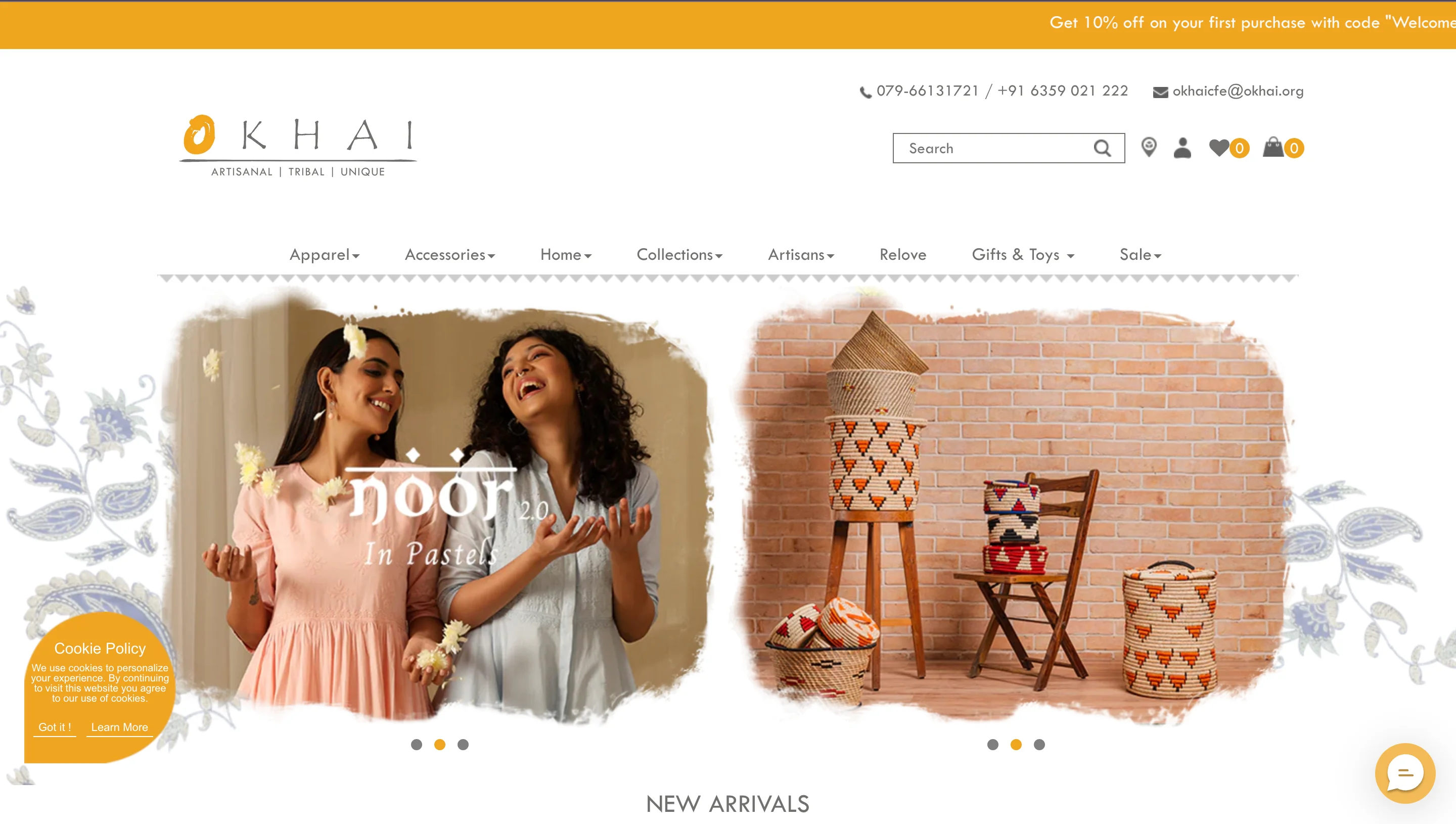
At Okhai, empowerment of women lies at the core of their ethos. Through their range of handcrafted clothing and lifestyle products, sourced from rural artisans across India, the brand strives to uplift underprivileged female artisans.
By providing fair wages and dignified work opportunities, Okhai aims to enhance the financial and social status of these artisans within their communities. This commitment to empowerment is evident in their intricately detailed garments, characterized by a vibrant palette of colors, reflecting both heritage and modernity.
4. The Terra Tribe
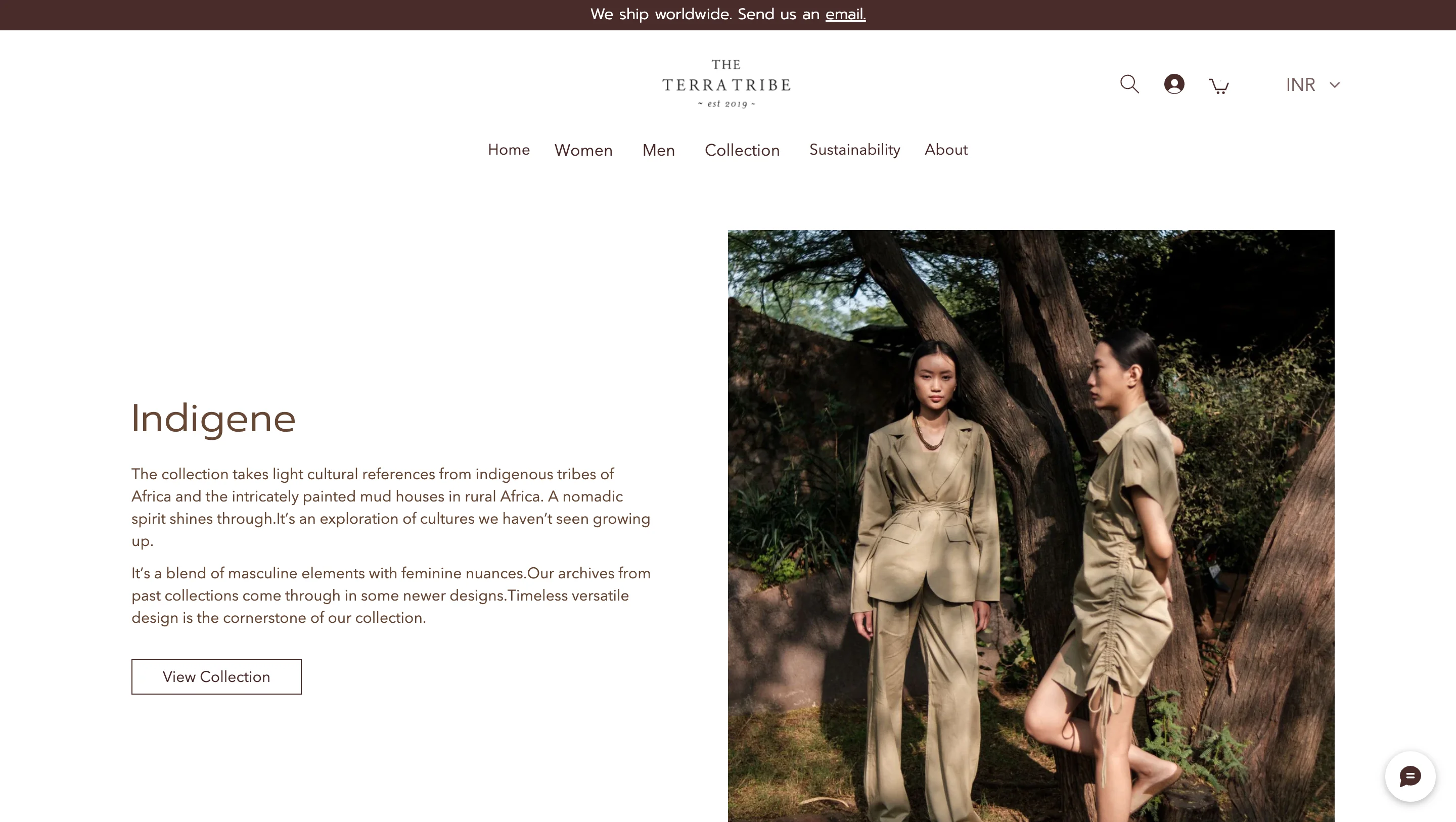
Embodying the essence of slow fashion, The Terra Tribe prioritizes quality over quantity with its limited production runs. Their collection of meticulously crafted womenswear features timeless designs, crafted entirely from locally manufactured Tencel and adorned with recycled metal trims.
True to its name, inspired by the Latin word for earth, the brand offers an earthy palette of colors derived from natural sources like Indian madder vines, natural indigo, iron vinegar, and leaves, reflecting a commitment to sustainability and artisanal craftsmanship.
5. Sui

Drawing inspiration from its namesake, the Indian word for needle, Sui epitomizes the essence of slow fashion. Collaborating with vetted NGOs in the handloom sector, the brand champions underprivileged women, empowering them through sustainable livelihoods.
Each meticulously crafted piece at Sui undergoes a process of herbal dyeing and is fashioned from organic cotton, hemp, linen, and other handwoven textiles. From 'gram-worthy dresses to intricately embroidered jackets, their current collection showcases covetable warm-weather essentials, blending style with a social conscience.
6. Grassroot by Anita Dongre
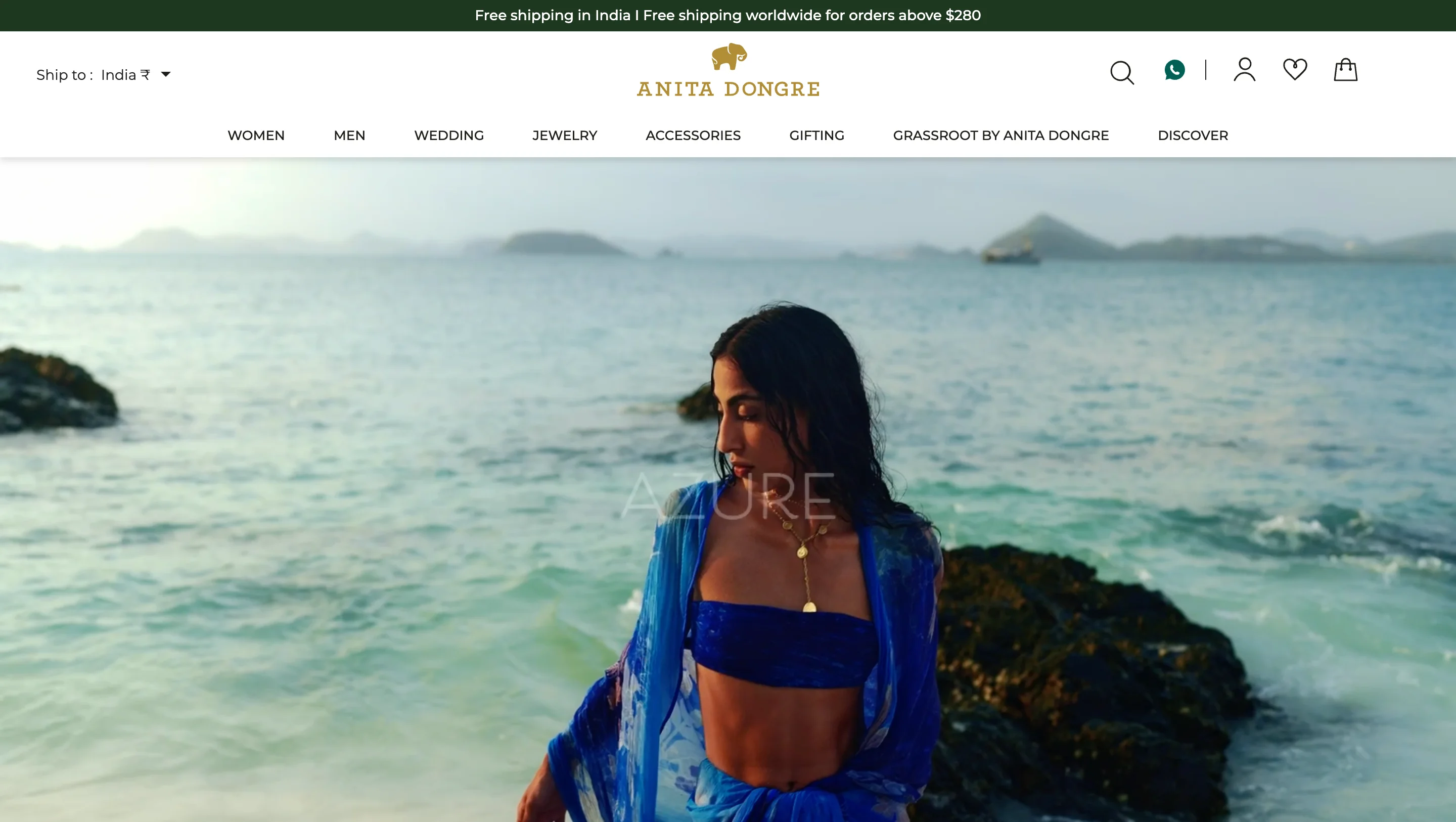
Grassroot by Anita Dongre stands as a beacon of ethically made sustainable clothing, embodying the rich heritage of Indian craftsmanship. Under Anita Dongre's stewardship, Grassroot employs female artisans from rural villages, preserving ancient Indian crafts and empowering local communities. From traditional sarees to intricately detailed kurta sets and dresses, Grassroot's collection exudes vibrancy and sophistication.
Each piece is adorned with hand-embroidered thread work or dyed using time-honored techniques, offering a captivating journey through India's cultural tapestry. What sets Grassroot apart is its versatility - kurta sets easily transform into separates, allowing for creative styling. Whether paired with denim shorts for a bohemian vacation look or accessorized with bangles for added flair, Grassroot pieces epitomize timeless elegance with a contemporary twist.
7. Oshadi
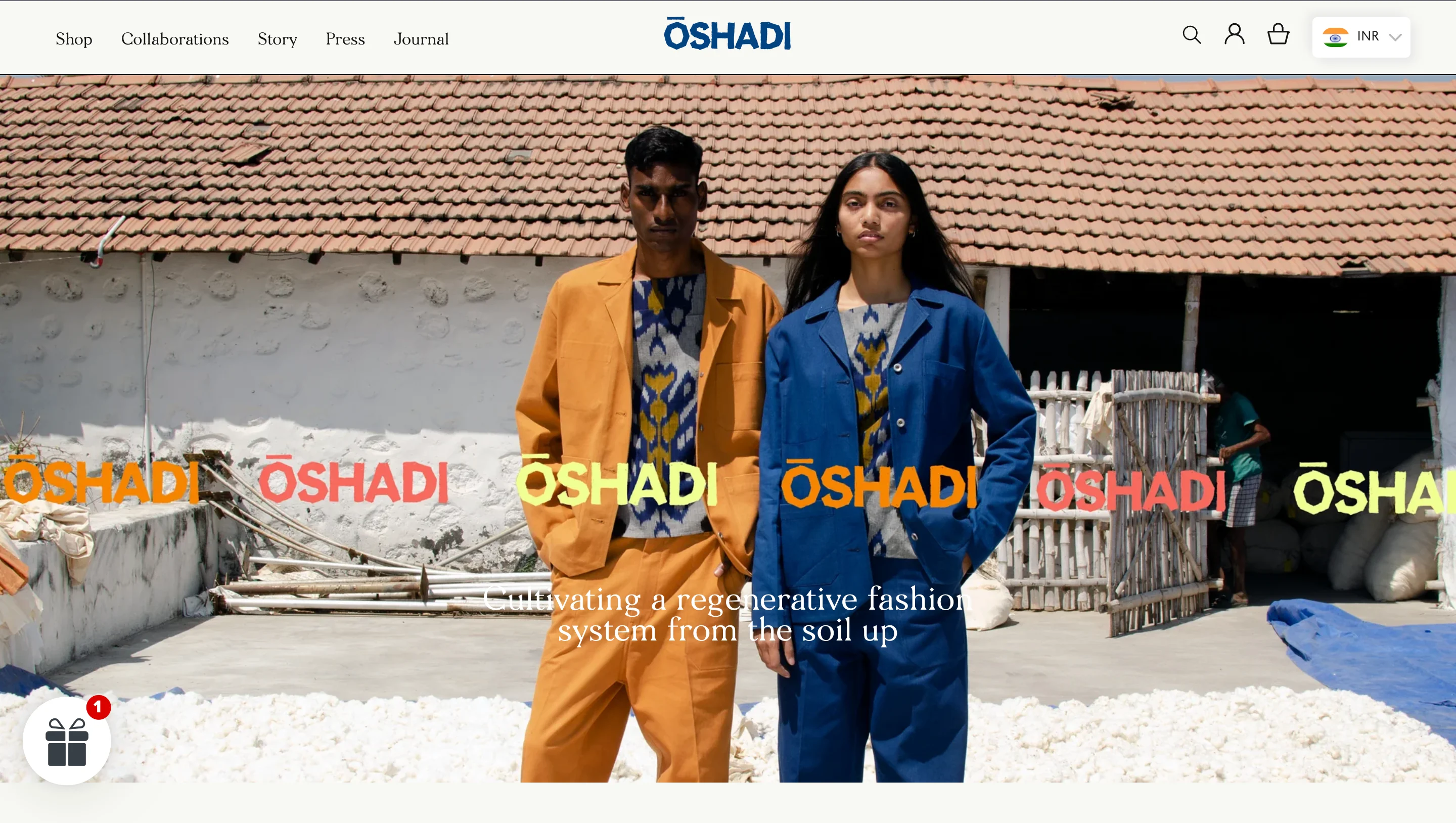
Oshadi, pronounced as aw-sh-dhi, derives its name from Sanskrit, meaning the essence of nature or a healing plant - a fitting reflection of its sustainable ethos. Originally established as a womenswear label in 2016, Oshadi has evolved into a vertically integrated 'seed-to-sew' sustainable supply chain. Central to their mission is the cultivation of cotton and indigo on their own farm, employing regenerative practices to replenish soil nutrients and support a circular fashion model.
For founder Nishanth Chopra, circularity entails more than just a continuous loop; it embodies a philosophy of repurposing, rebuilding, and recreating reciprocity within the supply chain. Alongside their commitment to sustainability, Oshadi offers a range of intricately dyed organic cotton clothing, exemplifying timeless elegance with a conscience.
8. Doodlage
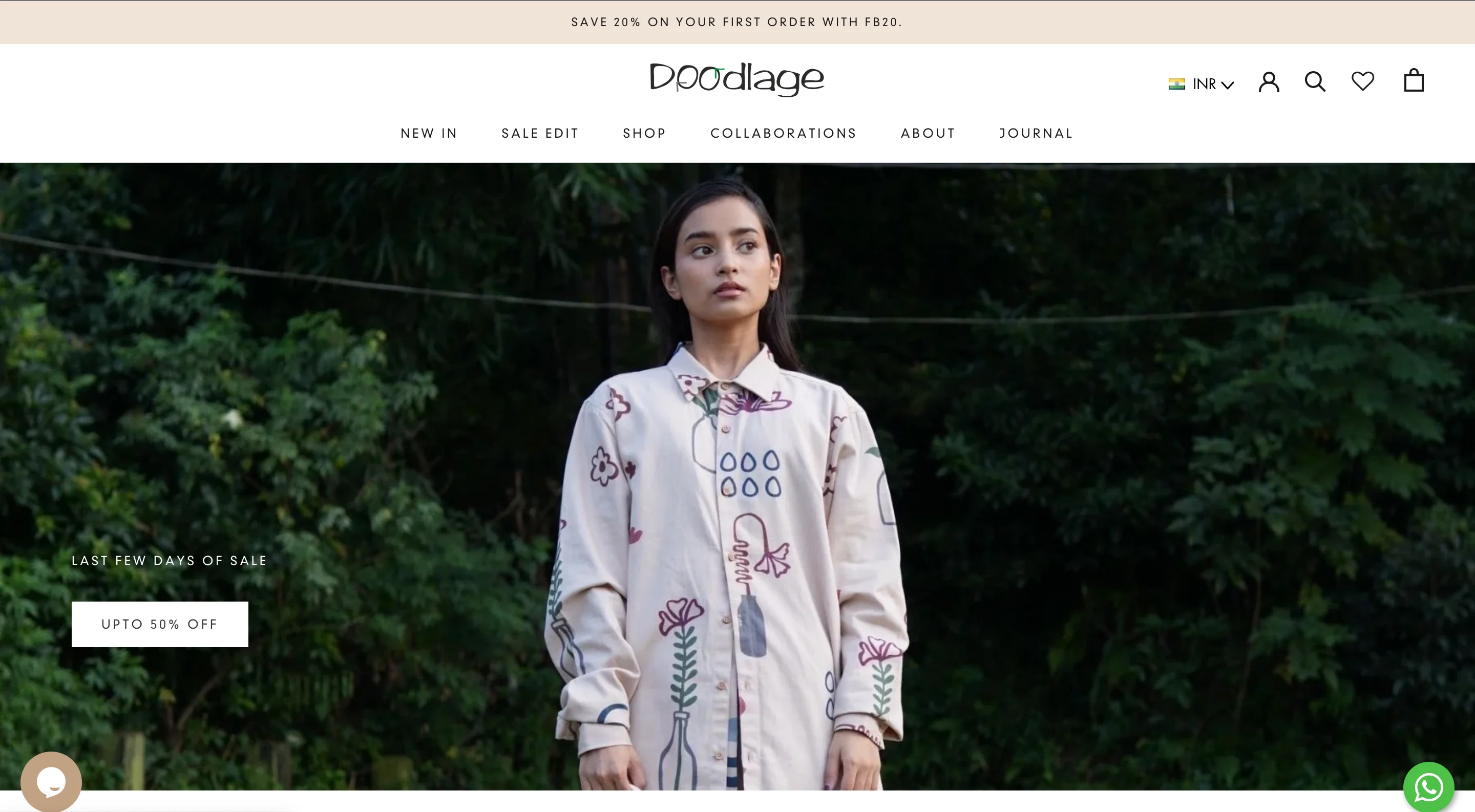
Doodlage epitomizes innovation in sustainable fashion with its mission to transform waste into wearable art. Utilizing deadstock fabric, the brand crafts timeless pieces that redefine the concept of 'patchwork.'
Their youthful silhouettes blend patterns seamlessly, offering a fresh take on traditional patchwork that transcends the conventional. Far from resembling your grandma's quilt, Doodlage's creations exude contemporary charm and individuality, challenging perceptions and inspiring a new era of conscious fashion.
9. Maati

Hailing from the picturesque city of Udaipur, Rajasthan, Maati captures hearts with its understated yet chic everyday staples. Collaborating with local communities, the brand produces unique handloom fabrics with minimal water and energy consumption.
These fabrics are then adorned with natural dyes sourced from turmeric, indigo plants, and various flowers, adding an eco-friendly touch to their creations. Maati's commitment to sustainability extends to its manufacturing process, where local artisans in Rajasthan are provided with fair wages and favorable working conditions, ensuring a sustainable livelihood for all involved.
10. Nicobar
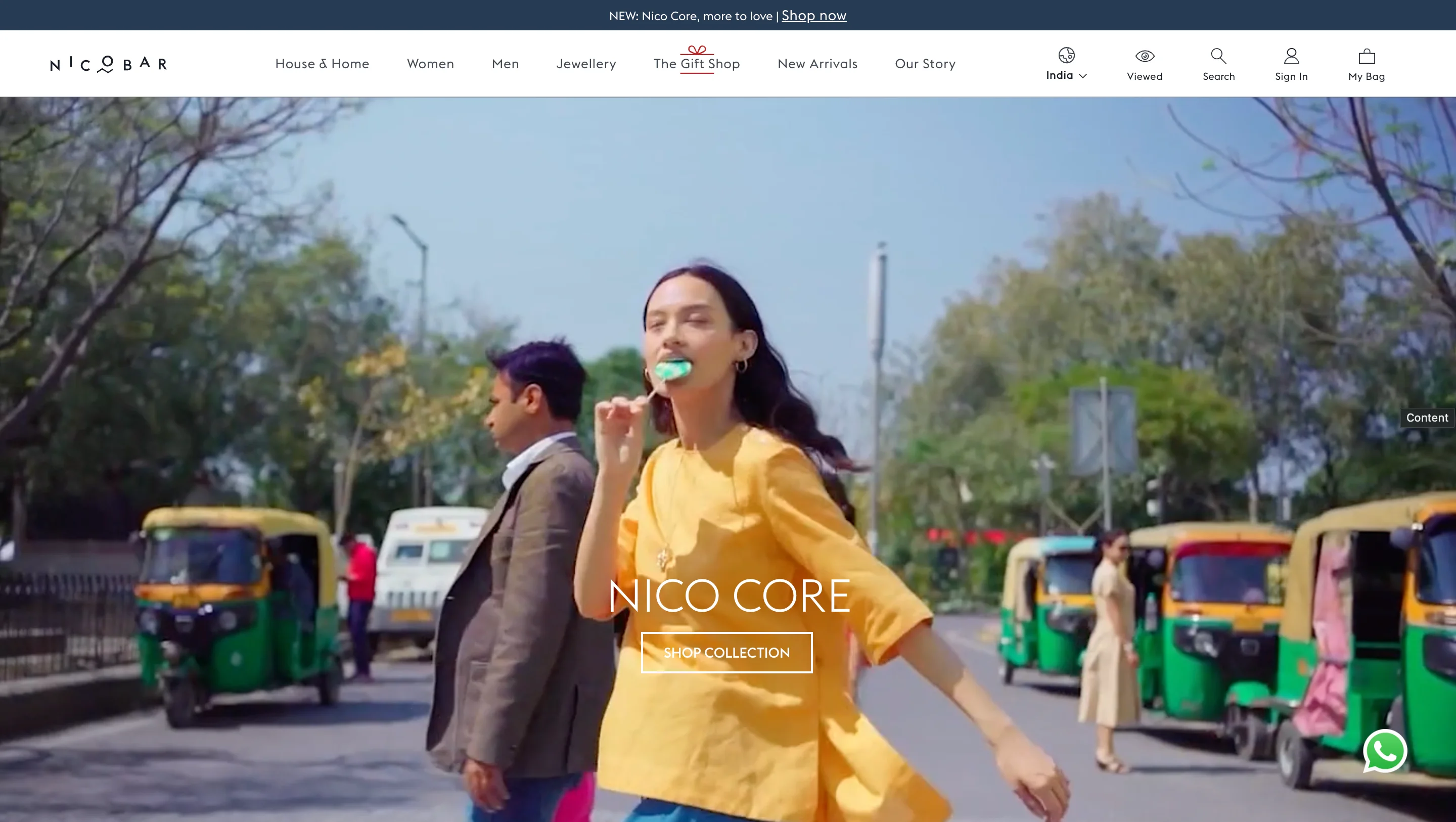
Nicobar epitomizes mindful fashion, offering timeless clothing crafted from sustainable materials such as organic cotton, Tencel, recycled wool, and Cupro Modal. Collaborating with small communities nationwide, the brand ensures ethical sourcing for its Merino wool scarves, while partnering with fair trade factories for clothing production.
Committed to sustainability beyond the garments, Nicobar has reduced plastic packaging by 85% since its inception, continually striving for operational improvements. Their collection of breezy wrap dresses exudes effortless elegance, perfect for any occasion, and embodies the essence of a classic going-out ensemble with a sustainable twist.
Indian Sustainable Fashion Marketplaces You Need To Check Out
Discover a new era of conscious consumerism with Indian Sustainable Fashion Marketplaces. These platforms curate a diverse range of eco-friendly and ethically sourced fashion brands, offering a guilt-free shopping experience. From organic cottons to recycled materials, these marketplaces showcase the best of sustainable fashion while supporting local artisans and communities. Embrace style with a purpose as you explore these hubs of ethical fashion, where every purchase makes a positive impact on both people and the planet.
1. GoFynd

GoFynd is a leading online marketplace that offers a curated selection of sustainable fashion from various brands. With a commitment to ethical sourcing and environmental responsibility, GoFynd provides shoppers with a seamless shopping experience while promoting sustainable fashion choices.
2. Virgio
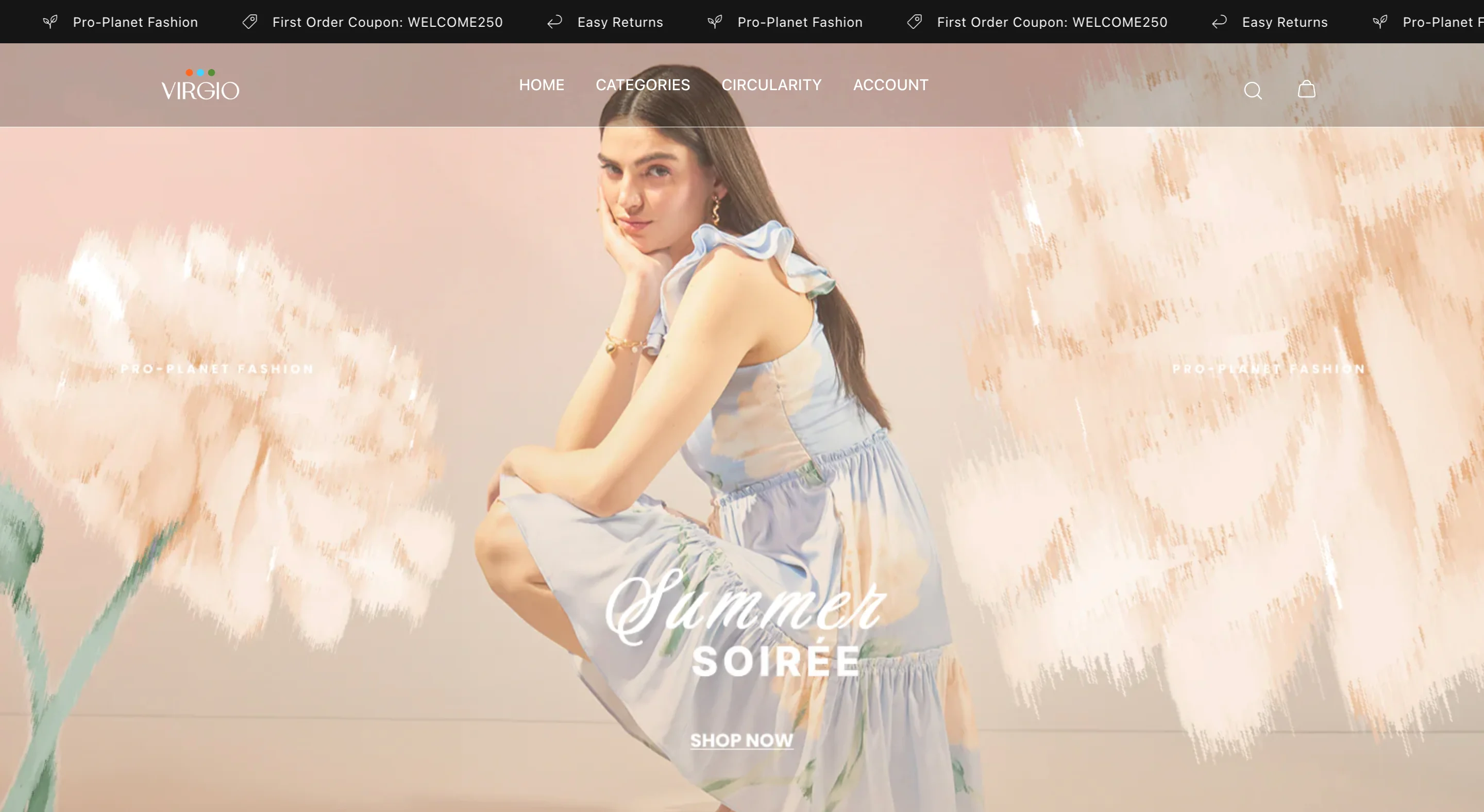
Virgio is a sustainable fashion marketplace dedicated to promoting eco-friendly and ethically made clothing and accessories. Through partnerships with sustainable brands, Virgio offers a diverse range of stylish and sustainable fashion options for conscious consumers.
3. Myntra

Myntra, one of India's largest online fashion retailers, has a dedicated section for sustainable fashion. With a focus on eco-friendly materials and ethical production practices, Myntra offers a wide range of sustainable clothing, footwear, and accessories for shoppers looking to make conscious fashion choices.
4. Brown Living
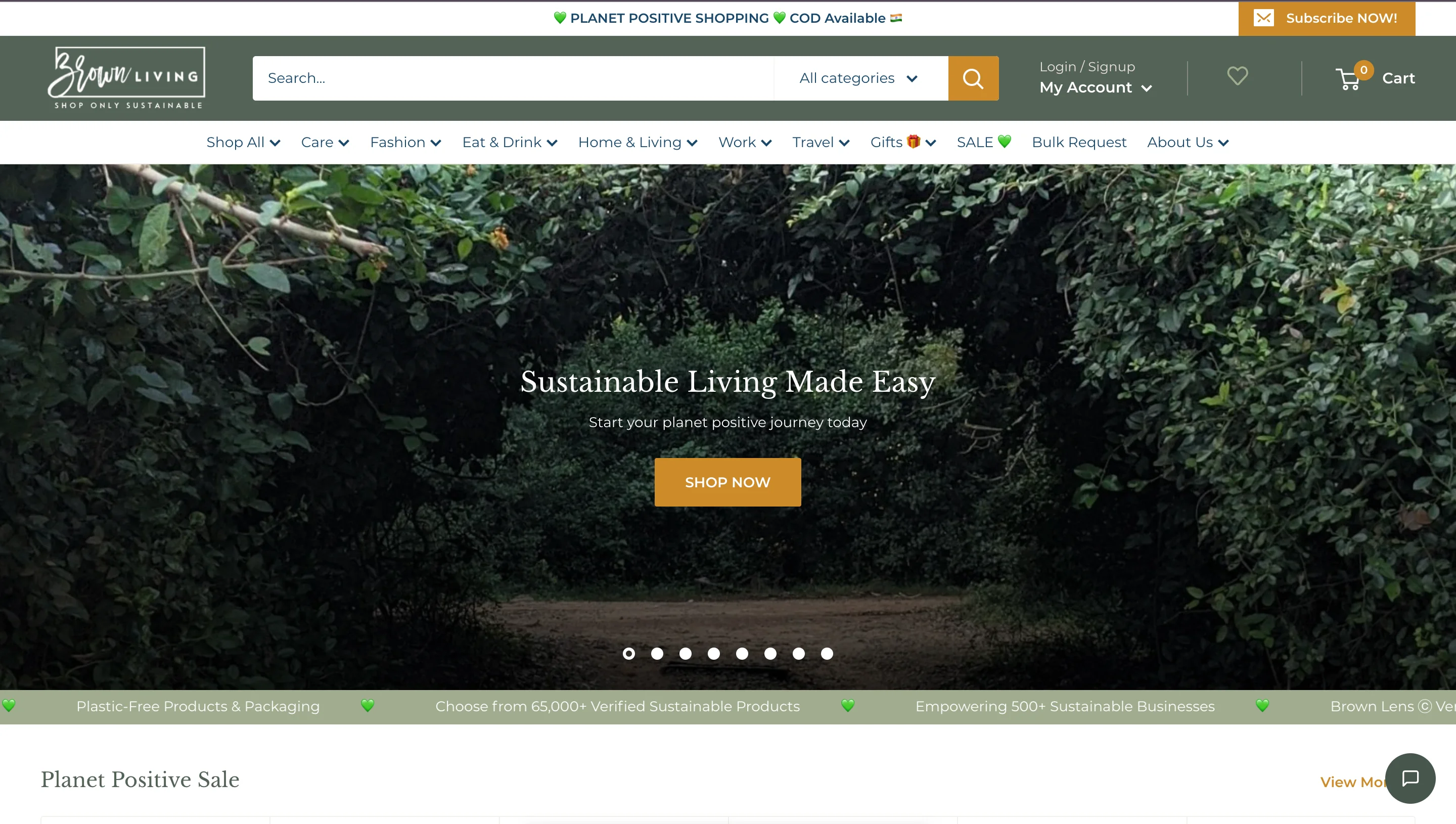
Brown Living is a sustainable marketplace that offers a curated selection of eco-friendly and ethically sourced products, including fashion, home decor, and lifestyle items. With a commitment to sustainability and social responsibility, Brown Living provides shoppers with a platform to discover and support sustainable brands and artisans.
5. Ajio
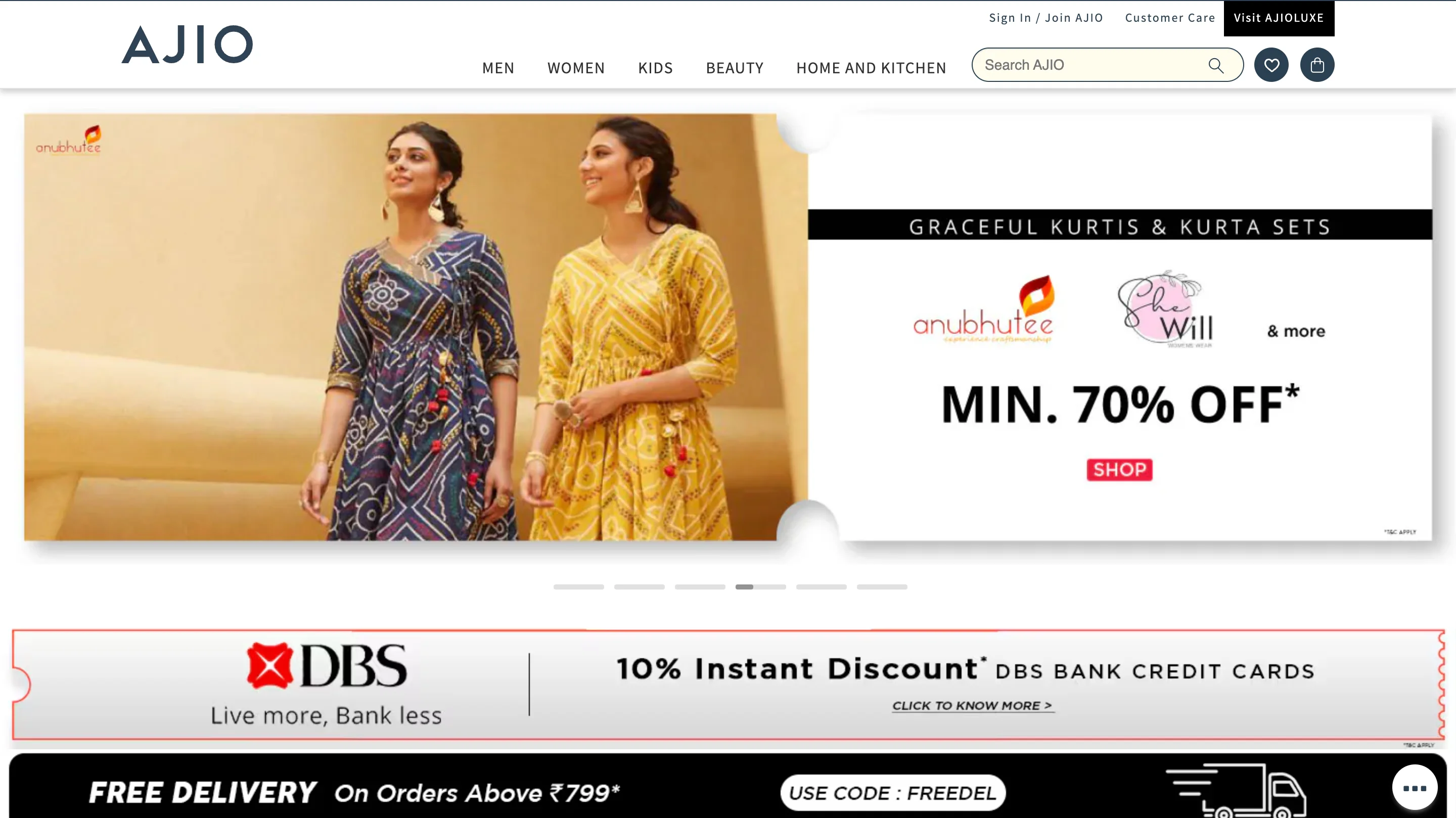
Ajio features a dedicated section for sustainable fashion, offering a wide range of clothing, footwear, and accessories from eco-friendly and ethical brands. With a focus on promoting sustainability and conscious consumerism, Ajio provides shoppers with stylish and sustainable fashion options for every occasion.
What is the difference between sustainable fashion and fast fashion?
Sustainable fashion prioritizes environmental and social responsibility, using eco-friendly materials and ethical production practices. Fast fashion emphasizes quick production of inexpensive clothing, often at the expense of environmental and social impacts.
Is Zara sustainable or fast fashion?
Zara is considered a fast fashion brand due to its rapid production cycles and focus on trendy, affordable clothing.
Is fast fashion cheaper than sustainable fashion?
Fast fashion is typically cheaper than sustainable fashion due to lower production costs and materials.
What is the difference between sustainable fashion and ethical fashion?
Sustainable fashion focuses on environmental impact, while ethical fashion emphasizes fair treatment of workers throughout the supply chain.
Is sustainable fashion good or bad?
Sustainable fashion promotes responsible consumption and production, reducing environmental and social harm. However, its accessibility and affordability may vary.
Is H&M a sustainable brand?
H&M has made efforts towards sustainability, but it still operates primarily as a fast fashion brand, facing criticism for its environmental and labor practices.
About the author






.webp)


.webp)
.webp)





